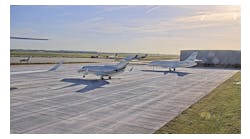With a roaring economy, slightly-rising-but-still-low interest rates, and continued growth in business aviation, a number of FBOs are in some stage of considering a hangar development project today. Perhaps such a project is a requirement of a recently minted lease document, one that prescribes a capital improvement investment in the leasehold. Perhaps existing hangars have been full for years, and the time just seems right to build another. Whatever the driver, the planning, design, and construction of a new hangar- or hangars- is a serious financial undertaking for an FBO, and not one to be taken lightly. In this series, we’ll explore just a few of the steps a wise FBO should consider well before they’ve planned the grand opening celebration of their to-be-built hangar.
Conduct a Market Study
Though it may be tempting to build a hangar “on spec,” to do so with very little research other than an aging spreadsheet of a hangar waiting list of potential customers, is a red herring. Timing of course, is everything, and this classic Ready-Fire-Aim scenario of a spec built hangar can have unintended consequences, including driving hangar prices down when too much supply is introduced in the form of an empty hangar. In extreme cases, a poorly-timed decision to build can saddle an FBO with a financial albatross- at least initially- one that can jeopardize the long-term viability of an otherwise profitable business. This is not suggest an FBO doesn’t know their own marketplace for hangar space, but the first step in hangar development is undertaking a market study of locally available hangar space, and its attendant pricing. And that market study begins with your FBO’s current hangar tenants, and a review of their subleases.
To begin the market study, first take stock of your FBO’s existing hangar space. Are your existing hangars actually full? If there’s maintenance cage, GSE cluttering the walls, or that one aircraft owner’s prize car or boat tucked away in a corner of a common-use storage hangar, that answer is likely no. When performing this analysis, consider the useable internal dimensions of the hangar if it had literally nothing in it but aircraft. Next, assuming the FBO’s existing hangar space is already being used effectively, has your FBO invested in a hangar stacking software program to ensure there’s not a more efficient way to position the aircraft? Specialty programs such as One Mile Up or STAX, are worth the investment, and inexpensive ways to validate more efficient aircraft parking scenarios.
Second, review your portfolio of subleases as part of the market study, and ask several questions: Do all your existing hangar tenants have current, signed subleases? What is the effective per square foot (PSF) rate for your hangar space? When was the last time your FBO raised hangar rates? The point of this self-reflection when conducting a market study is de-risking a contemplated hangar development by getting “the house in order” first. If your FBO is at 100 percent hangar occupancy or more, but you have no legal instruments in the form of subleases in place, stop and de-risk a future hangar development by inking solid agreements with existing tenants that guarantee future revenue. Likewise, if your hangar waiting list a mile long, but prices haven’t been increased in years on your existing tenants, stop, and raise hangar prices. While the latter is perhaps a blunt statement, this is the basic economic principle of pricing elasticity of demand. The goal is to ensure- long before a shovel touches the dirt- that the FBO is on solid footing with its exiting hangar tenants by having current subleases in place with pricing at full market rates, in full hangars, before any next steps are taken.
But don’t reach for the shovel yet, there’s much more to be considered in the market study. Wise FBOs will consider researching the PSF rate and other attributes of available hangar space on airport not controlled by the FBO, such as the airport itself or space controlled by a competing FBO at the airport. Regional area pricing for hangar space also should be considered at nearby airports. Though far from complete, a final step in a market study may include consideration for one-time events that effect short and long term demand, such as a runway closure of a nearby airport for construction.
Align your Airport Lease
Though most FBOs do not undertake hangar development without adequate time remaining on a lease to amortize said capital improvement, another box to be checked in the diligence process is exploring if a potential lease extension with the airport is available. Rare is the airport that shuns private sector development on its leaseholds, as such investment adds value to the users of the airport itself, and the improvements are usually reversionary at the end of lease term. It’s a win-win for an airport. Because of that, many airports will consider lease extensions for leasehold improvements by lessees, such as an FBO. And, while long term leases tend to need to go before a local municipality, airport authority or other governing body for approval, many airports themselves are empowered to unilaterally make short term lease extensions, so long as the term is under a certain threshold. Hence, while a new 35 year lease may take literally years of negotiation to finalize, an Airport Director may be empowered to execute a short term extension, such as five to ten years with the proverbial stroke of a pen.
A short term extension is especially appropriate if an FBO is in mid-lease cycle, but market demand clearly dictates – and the market study concludes- that a new hangar development is the right course of action. For example, with 15 years to go on a lease or less, few would voluntarily undertake a major hangar development - even if market conditions demonstrate a demand. Yet a 10 year extension literarily changes the math, and can breathe new life into such a project. Finally, additional discussion points for the hangar development lease extension conversation with airport may include a reasonable ground rent abatement or reduced lease rates during construction.
In the next installment in this hangar development series, we’ll discuss selecting a design-build partner and creating a pro forma financial model.



